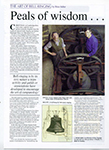THE ART OF BELL-RINGING |
 |
<<Click to see original |
CHRISTMAS in Cambridgeshire. And what could be more quintessentially English than the sound of church bells ringing out before Midnight Mass on Christmas Eve?
If you've ever stopped to listen to those bells, you will have noticed that they sound unlike almost any others in the world. The tradition of 'change-ringing' originated in Britain and is mainly confined to here, with over 5,400 rings around the country, nearly 140 of which can he found in Cambridgeshire.
In the 16th century, ringers developed a system of full-circle ringing, so that the bell starts from a mouth upward position, swings through a full circle and comes to rest mouth upwards again, before swinging back again full circle in the opposite direction.
To enable a bell to be swung in this way, a wheel is attached to the bell and a rope tied to the wheel, so that the ringer can control the swing of the bell by varying the time during which it is held on the balance point with its mouth upwards. This slight variation enables a change in the order in which the bells sound each time they are rung, but it is only practicable for a bell to change places with its immediate neighbour, so tunes are not possible on bells hung for full-circle ringing.
The bells begin by ringing a downward scale, from the lightest (treble) to the heaviest (tenor); on six bells this scale ean be written as 1-2-3-4-5-6. From this point, the conductor can call out the numbers of the bells which are to change position to obtain a new sequence — eg by calling 'three to four' the sequence 1-2-4-3-5-6 is produced.
More experienced bands progress from these 'call changes' to 'change-ringing', where the sequence of the bells alters at every stroke according to a predetermined pattern.
In the most basic (Plain Hunt) the bells follow a regular path to the front of the queue and then to the back, and so on. Many dozens of methods are derived from slight variations on this pattern and are known as plain methods.
In the early days of change-ringing bands used rings of eight bells and mainly rang changes on seven of them, the tenor bell striking last after each change. By ringing all possible permutations of the seven bells, a total of 5,040 changes is produced, and this came to be known as a peal. Not once is any permutation repeated, otherwise the peal attempt is deemed to have failed!
(You can calculate the maximum possible number of permutations by factorialising the number: eg six bells have 6x5x4x3x2 = 720 permutations, while four bells can be rung in a maximum of 4x3x2 = 24 permutations.)
Bell-ringing is by its very nature a team activity and guilds or associations have developed to encourage the art of campanology. The earliest such societies were London-based and modelled themselves on the ancient Liveries of the City, with a Master, Stewards and so on.
One such society, known as the Ancient Society of College Youths, was founded in 1637 and provides ringers for St Paul's Cathedral, Westminster Abbey, and several other notable London churches. Membership is by election, is greatly coveted and is still restricted to male ringers.
If you're at all interested in learning the ancient art of campanology, most ringers will welcome you if you just turn up on practice night. It might well take you up to a year to be fully competent at ringing rounds and call changes, but be warned: bell-ringing has an insidious habit of taking over your life!
